Richard Bayliss
| Richard Bayliss | ||
|---|---|---|
| Name | Richard Bayliss | |
| Pseudonym | Starhawk | |
| geboren | 25.12.1978 | |
| Nationalität | Großbritannien | |
| Branche |
| |
Richard Bayliss ist ein C64-Musiker und Coder von Demos und Spielen. Er wurde am 25.12.1978 geboren und kommt aus South Birmingham, Großbritannien. Weitere Details schildert er in seiner Lebensgeschichte.
Viele seiner Spiele hat er mit SEUCK erstellt. Er hat im Jahr 2000 die Gruppe "The New Dimension (TND)" gegründet, damals noch als "Einmann-Gruppe", seit 2001 ist seine Homepage online. Außerdem arbeitet er aktiv beim Diskmag GameOver(view) mit und gehört zur Gruppe Blazon.
Entwickelte C64-Programme (Auszug)[Bearbeiten | Quelltext bearbeiten]
Dies ist nur eine kleine Auswahl der von Richard Bayliss entwickelten Programme und Spiele:
Spiele[Bearbeiten | Quelltext bearbeiten]
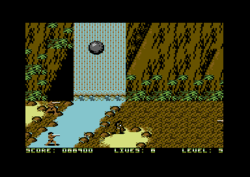
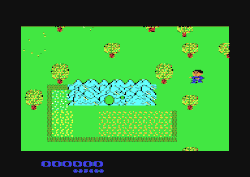
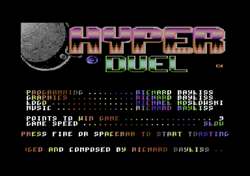
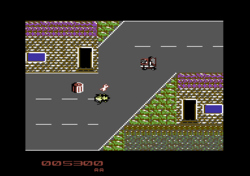
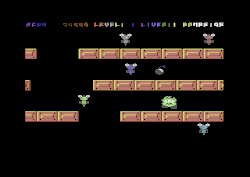
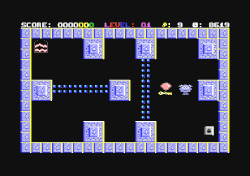
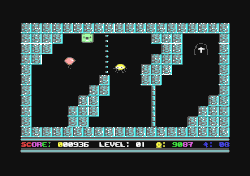
- 2022
- Alpacalypse
- Cosmic Combat Deluxe V1.2 (Final Edition)
- River Barrage
- Weights and Crates
- Weights and Crates Deluxe
- 2023
- Blastopia DX - Special Edition
- Darkland 2 (auch Musik)
- For Speed We Need 3
- Herisferix
- Hyper Harvest (PD)
- Lunar City
- NewsStand
 /
/ 
- Snake vs Bomb 2: Canyon Chaos
- Yauzeras
- 2022
- Careers (nur C128; PD)
- Cruiser-X 79
- Darkland (auch Musik)
- Fold'em II (PD)
- Gold Quest VI (Titelmusik)
- Lane Crazy
- Little Nippers
- Little Nippers DX
- Master of Tiles
- Poing Ultra
- Promethean Legacy (PD)
- SEUCK Title Screen Maker V1.5+ (Tool)
- Sever the Wicked!
- Slug vs Lettuce
- Snake vs Bomb
- Tasered in the Crotch
- 2021
- Cosmic Combat DX
- Droid Rumble
- Gyro Run
- Jump Out (PD)
- Nixy The Glade Sprite
- Para Lander DX
- Ray Fish DX
- Retaliate DX (Multilingual)
- Seaquest
- Shock Raid
- Spider Fighter
- Star Hawx
- Tubes'n'Balls (PD)
- 2020
- Caveman
- Fold'em (PD)
- Infinite Space (PD)
- Juanje Juega in Sinverland
- Killer Saucers
- Kugelblitz
- Mega Tank Blasta!
- Merge 64 (PD)
- Planet Balls (PD)
- Storm Chase
- Synthia in the Cyber Crypt
- Toilet Paper Stacker
- Toxic
- Zap Fight 3
- Zap Fight Trilogy
- Zzapped in the Butt DX
- 2019
- 4 a Win (PD)
- Amazon Tales (1. Version in 2012; 16KB-Version; damals nur 75% Fertigstellung)
- Blastopia DX (RGCD 16KB Compo 2019 edition)
- Forgotten Forest
- Gigablast: Gold Edition
- Hanoi Tower (PD)
- Happy Blocks DX (Full release version)
- Legion of the Damned 3
- Let's Invade 2
- Rocket 'N Roll
- Run Demon Run
- Squibblies 3 - Mucus's Revenge
- Starfysh Remix
- 2018
- Arhena! The Amazon: Special Edition
- Barriers (PD)
- CETI 21 - Special Edition
- Operation Metalstorm
- Precinct 20: Dead Strange
- QUAD CORE C64
- Rabid Robots 4K
- Rogue Burger One (PD)
- Spider Maze
- Split Second
- Starfysh Remix
- Valkyrie III: The Night Witch
- 2017
- Abu Simbel Profanation
- Antarta! (PD)
- Border Blast 3 (Enhanced version)
- Dark Destroyer 2117 RX
- Delta Run
- Delta Run RX
- The Sky is Falling
- Spyders (PD)
- Starfysh
- Star Toast
- Valkyrie II: The Templar
- Vortex Crystals (Full release version) - 2015/17 (16 KB-Version)
- Zap 'N Load
- Zap Fight II: Zapped into Oblivion
- 2016
- Blap 'n Bash
- Blap 'n Bash - Revisited (16 KB-Version)
- Eye of the Gods
- Granny's Teeth
- Honey Bee
- Hover Raider
- Let's Invade!
- Night of the Valkyrie
- Slime Deluxe (PD)
- Super Silverfish
- Zap Zone
- 2015
- Abyssonaut (PD)
- Big Mech Alpha
- Blitz-A-Load
- Darkland (2015) (Urversion)
- Dark Destroyer 2117 (Scene World-Diskmag)
- Flying Cobra RX
- Nuclear Strike Force
- Pixel Pix
- Snatch McBlagger (PD)
- Sopwiths and Pterrordons
- Trance Sector Ultimate
- X-Force (Final release version)
- 2014
- Another Day, Another Zombie
- Aviator Arcade (PD)
- Dark Force
- Dark Force - Redux
- Hero Time II
- Honey Bee - Redux (RGCD 16KB Compo 2014 edition)
- X-Force - 2015/14
- Tau Zero Redux
- Zap Fight
- Zappy Bird
- 2013
- Aleste
- Bank Run
- Berzerk Redux (Unofficial conversion)
- Cowboy Duel: Live Your Dream! (PD)
- Dodo's Deep Doo-Doo
- Flubble and Squij
- Guns 'n' Ghosts
- Invert
- Planet Popper
- Re-Alienator
- Realms of Midgard
- Revenge of the Tomato
- Sheepoid DX
- Sheepoid Deluxe (16 KB-Version, Psytronik-Edition)
- Spy Rider
- Woolly Jumper
- Zombie Brain Eaters
- 2012
- Trance Sector (Demo) (mit 14 spielbaren Levels)
- Woolly Jumper (aka Sheepoid 2) - 2012/13 (16 KB-Version, Psytronik-Edition)
- Wyvern
- 2011
- 2010
- Bionik Granny Returns
- Mutilator
- Nyaaaah! - 15th Anniversary Edition
- Spittis Search V2
- Toxic (4KB-Version)
- 2009
- Bah, Humbug!
- Bomb Chase 2009 - Special Edition
- Trash Course (Weiterer Entwickler: Sledgie)
- 2008
- 2007
- 2006
- 2005
- Balloonacy 2
- Deep Sea Salvage
- For Speed We Need V2
- Grid Zone - Remix (Cronosoft)
- Jeffy
- Protectoid
- Xmas Crazy
- 2004
- 2003
- For Speed We Need
- Froggy Goes Splatt!
- Gift Craze
- Gravity 3
- Missile Blasta
- Nyaaaah!
- Sharkz II V1.2
- Shgut Down
- Super Galaxys Duel
- Super Seven
- Switch It!
- Wash Out
- 2002
- Bomb Chase
- Capture 2
- Cherry Dash
- Galaxys
- Ouch! 2
- Poing
- Psycho (TND)
- Pudding Breath
- Star Blazers
- Super Pac Twins
- 2001
- 2000
- Blast Fast
- Defuzion 2
- Drop Down
- Fluff
- Gravity
- Gravity 2
- Heavy Metal Solid (Preview)
- Magyk
- Ouch!
- Robot
- Stealth 4
- 1999
- Cetimiex
- Freespace 2075
- Hysterix
- Moon Madness
- Target-X - 1999/2000
- Sheepoid- 200?
- 1998 und früher
- Sliggy S.O.S - 1998
- Anger - 1991
- Ants at War - 1991
Musik[Bearbeiten | Quelltext bearbeiten]
- Gold Quest 6 - 2022
- Spittis Search V2 - 2010
- Trash Course - 2009
- Gold Quest 4 - 2008
- Gold Quest 2007 - 2007
- The Vice of Miami - 2006
- That Annoying Ring Tone - 2006
- Gold Quest III - 2006
- Gold Quest II - 2006
- Gold Quest - 2005
- Balloonacy - 2001
- Sub Hunter - 2008
Demos[Bearbeiten | Quelltext bearbeiten]
- Dancing Dawg - 2005
- Goldfish Demo - 2004
Tools[Bearbeiten | Quelltext bearbeiten]
- Extreme Demo Maker PAL+NTSC - 2005
- SEUCK Buster V1.2 - 2007
- SEUCK Title Screen Maker V1.8+
- Tape Master Pro
Seine Lebensgeschichte[Bearbeiten | Quelltext bearbeiten]
(2005)
Ich heiße Richard Christopher Bayliss. Ich bin 27 Jahre alt und lebe in South Birmingham in Großbritannien. Ich bin Lagerverwalter im pharmazeutischen Großhandel und stelle für Chemiker im Bereich Midlands, London und Northamptonshire nach deren Bestellungen Lieferungen zusammen. Meinen ersten C64 bekam ich mit 11 oder 12 Jahren zu Weihnachten als Geburtstagsgeschenk. Damals spielte ich hauptsächlich.
Zur kreativen Seite des Commodore 64 kam ich, als ich zum ersten Mal Sensible Softwares Shoot ’Em Up Construction Kit (SEUCK) benutzte. In den 90ern gab es einen regelrechten SEUCK-Kult. Ich gebe es zu. Das erste Spiel überhaupt, das ich geschrieben habe, war nicht wirklich toll. Ich hatte nur ein bisschen mit Grafik herumexperimentiert und halt mit diesem Werkzeug gespielt. Wie es hieß? „Clip Clop“. Das Spiel verwendete Hintergründe aus SEUCKs Slap&Tickle, aber die Sprites waren echt doof, der Spieler war ein schwarz-orangenes Quadrat und die Geschosse waren weiße Quadrate. Verrückte Feinde gab es auch, verschlossene Fenster und anderer Unsinn.
1994 lernte ich endlich ein bisschen in BASIC zu programmieren, was darin mündete, dass ich Spiele schrieb, wo alle Objekte so rollten und du musstest die Leertaste drücken, um drei gleichfarbige Kugeln in eine Reihe zu kriegen. Wenn es drei grüne Kugeln waren, bekam der Spieler Punkte, wenn das nicht klappte, war das Spiel zu Ende. War ziemlich einfach zu programmieren, aber machte mir riesigen Spaß. Ebenfalls 1994 kaufte ich mir ein Utilitys-Tape aus dem PD-Pool von Binary Zone, ich hatte eine Besprechung davon im Commodore Format Magazin (Ausgabe 44) gelesen. Daraufhin fing ich an, mit verschiedenen Editoren rumzuspielen, Grafikprogramme, Sprite-Editoren und Musikeditoren wie Future Composer, DMC, USA Music Assembler und andere.
1995 dann holte ich mir tonnenweise Tools und Toolsammlungen aus den Public-Domain-Archiven (na ja, ich musste ja alles kaufen und die Sachen waren schön billig, was man bezahlen musste, waren grad die Disketten und das Kopieren, so rund 1,25 Pfund). Der Gegenwert war jedenfalls ausgezeichnet. Megatronix PD hatte eine ganze Bandbreite von Tools-Disketten und ich dachte, probier einfach mal alles aus. Im gleichen Jahr lernte ich auch das Hacken – ähm, nicht wirklich Hacken, aber jedenfalls IRQs rippen und sowas. IRQs selber zu programmieren lernte ich erst vier Jahre später. 1995 rippte ich also IRQs und importierte Musik, die ich im DMC und anderen Composern hergestellt hatte, in meine BASIC-Spielchen.
Ich machte damals Hunderte und Tausende Spiele mit SEUCK. Nyaaaah! War dann das erste, das ich als Public-Domain herausgab. Als Bonus für Binary Zone PD fügte ich Musik mit ein, eine Bearbeitung des Songs „Pianowork“, das Brian (von der Gruppe Graffity) mit DMC gemacht hatte. In dieser Zeit kam ich langsam dahinter, wie ich an meinen SEUCK-Sachen rumbasteln konnte, um sie anders zu machen. Ich hab z.B. die Farbbalken mit neuen Rasterbar-Farben aufgepeppt. Hat mir gut gefallen. In SEUCK kann man nämlich die Farbbalken eines Spiels nicht manipulieren, es sei denn, man benutzt den Maschinensprachemonitor im Action-Replay-Modul.
So war 1999 das Jahr, in dem ich mit Assemblerprogrammierung anfing. Mein allererstes in Assembler geschriebenes Spiel hieß Cetimiex, ein Name, der offensichtlich neu war und genauso beschissen. Wie dem auch sei, es war mein erster Versuch, ein Spiel in Assembler zu coden, das musste ja schief gehen. Massenhaft Fehler darin, unbehebbar, denn ich lernte schließlich noch. Mein Haupt-Spieleprojekt 1999 war Target-X und ich brauchte ein paar Wochen dafür. Als es fertig war, sah es – trotz der Fehler – richtig gut aus.
Es dauerte aber noch bis 2001 bis ich dann in die Szene eintauchte und die Website The New Dimension ins Leben rief. Die Demogruppe Civitas wollte mich damals gleich als Musiker für sich rekrutieren. Ich sagte Ja. Musik war meine Stärke und wurde in der Szene zu meiner Aufgabe. Im Programmieren war ich weniger gut. Allerdings habe ich mit der Zeit aus Spaß so allerhand Fungames geschrieben, und heute ist meine Webseite vollgepfropft mit praktisch jedem jemals von mir entworfenen Spiel.
Ich habe in der Szene nicht nur Spiele geschrieben. Auch Introkram für meine eigenen Spiele habe ich gemacht, wovon die Leute schnell sagten, lass den Quatsch, die sehen aus wie Cracktros und machen nur die Dateien länger. Anfangs benutzte ich TND-Intros, um mein Label herzuzeigen, aber später ließ ich diese Cracktro-Stil-Introsachen weg und die Spiele kamen als sie selbst. Wie diese Intros habe ich auch Demos geschrieben, manchmal mit anderen zusammen. Das beste in meinen Augen war mein Anteil an Cosines Singles-Demoprojekt. Ich war selber ganz beeindruckt von meiner Arbeit. Es war eigentlich ganz einfach zu coden, sah aber ziemlich gut aus. Vor allem wegen JSLs Logo/Bild.
Im Lauf der Zeit machte ich immer mehr Spiele, die besten davon sind Balloonacy (das gefiel den Leuten richtig gut), Balloonacy 2, Bomb Chase, Grid Zone Remix (eine Menge Leute mögen diese verbesserte Version von Grid Zone) und Heavy Metal Deluxe.
Freundliche Grüße
Richard Bayliss
(Übersetzung: Arndt Dettke)
Originaltext: Lebensgeschichte von Richard Bayliss - fürs C64-Wiki[Bearbeiten | Quelltext bearbeiten]
(2005)
My name is Richard, Christopher, Bayliss. My age is 27 years old and I live in South Birmingham, United Kingdom. My occupation is a warehouse assistant at a pharmaceutical distribution company where I have to pick orders and pack them ready for carriage to chemists around the Midlands, London and Northants. I first owned a Commodore 64 when I was 11 or 12 years old, as a Birthday present on Christmas day. I was mainly a games freak then.
I first got into the creative side of the Commodore 64 by using Sensible Software's shoot 'em up construction kit. There was a SEUCK cult in the 1990's. I have to admit. The first ever game I wrote was nothing too special. It was just an experimentation on creating graphics and generally playing around with this tool. What was my first game? It was called "Clip Clop". The game used background from SEUCK's Slap & Tickle, but the sprites were completely daft. The player was a black and orange square and the bullets were white squares. There were mad enemies too, which included barred windows, and other silly sorts.
In 1994 I learned small bits of BASIC programming and started to end up with games, where each object kept rolling, and you had to hit the Spacebar, to see whether or not you get a match of 3 coloured balls in a row. When people pressed space, if there was a match of 3 green balls in a row, the player won points. Else if they failed to match the 3 balls then game was over. It was simple to code, but I found it to be fun. 1994 was also the year I bought a utilities tape from Binary Zone PD, after it was featured in the Commodore Format magazine (Issue 44). This was when I started to play around with different graphics editors, sprite editors and music editors like Future Composer, DMC, USA Music Assembler and other tools.
1995 was the year I started grabbing loads of tools and tool collections from public domain libraries (Well, I had to buy those and they were really cheap. All being charged were disks and copying fee which was about £1.25). The value for money was excellent. Megatronix PD had a massive range of tools disks that I thought I check out and play with. 1995 was also the year I learned hacking - erm, not hacking exactly but ripping IRQ interrupts, etc. It wasn't until 1999 I learned to code IRQ. Anyway back to 1995. The interrupts were ripped, and I used to import music that I created in DMC or any other music composers and import those into my own BASIC game creations.
Those years I still made loads and loads of games using SEUCK. Nyaaaah! was the first ever game I released to the public domain. As an added bonus, when I released this game to Binary Zone PD, music was added to the game. It was a rendition of a tune called "Pianowork", which Brian/Graffity did on the DMC player. Through those years, I was learning to hack my SEUCK creations to try and do something different. The only best thing that I could do was update the colour bars with some more nice raster bar colours. I was very pleased with my result. You'll notice how in SEUCK you can't manage the colour bars of your own SEUCK game, unless you could enter the M/C monitor on the action replay.
1999 was the year I moved on to assembly coding. My first ever assembly coded game was call Cetimiex. The name was obviously non-existant and was plain shit. However, it was my first attempt at coding a game and it had to be bad. The game had loads of bugs in it, which could not have been helped, as I was learning at that time. The main game project in 1999 was Target-X, which took a few weeks to create. Once this game was finished, it turned out to be a good result, despite bugs still there.
It wasn't until 2001 I joined the scene and launched The New Dimension web site brand. I was invited to join a demo group called Civitas as a musician. I agreed. Music was my strongest task in the scene. Programming was my weakest. However, as time moved further, I created more and more fun games for fun, and now my web site seems to be crammed with practically every single game creation I produced.
It is not only games that I created in the scene. I also created stuff like intros to link to my own games. People asked me to stop making those intros for my own games as they look more like cracktros and make file size longer. I used TND intros in the past, to show off my own label. However later games never used the TND cracktro-style intros the games were on their own. As well as intros, I used to create my own demos, and co-op demos. The best demo in my experience so far had to be the demo part I wrote for Civitas' entry for Cosine's Singles demo project. I was impressed with my result. It was something simple to code, looked very nice. Especially with JSL's logo/picture.
As times moved on and on. I created more and more games, but the best game that I created had to be the following titles: Balloonacy (People loved this game), Balloonacy 2, Bomb Chase, Grid Zone Remix (Loads of people like this enhanced version of the original Grid Zone) and Heavy Metal Deluxe.
Friendly regards: Richard Bayliss